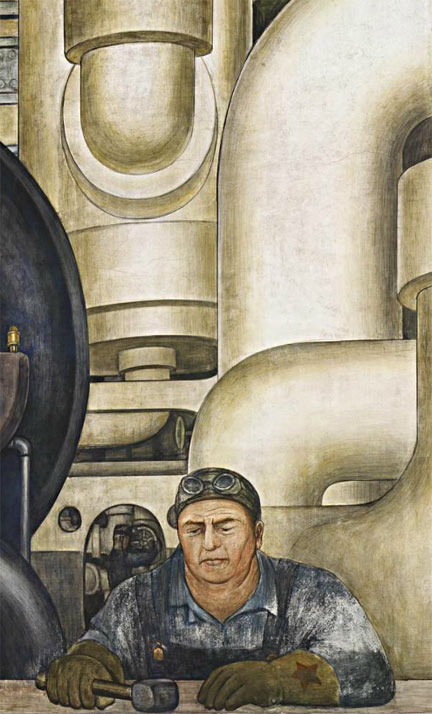A National Historic Landmark?

On April 23, 2014, the US Secretary of the Interior, Sally Jewell, and the Director of the National Park Service (NPS), Jonathan B. Jarvis, announced four new “National Historic Landmarks” for the United States. The Detroit Industry murals painted by Diego Rivera at the Detroit Institute of the Arts (DIA) in Detroit, Michigan were among the new landmarks.
Detroit Industry joins 2,540 sites across the US now recognized by the government as possessing “exceptional value and quality in illustrating or interpreting the heritage of the United States.”
In part, the dual press release from the US Department of the Interior and the NPS, read: “Considered by many scholars to be Rivera’s greatest extant work in the United States, Detroit Industry is an exemplary representation of the introduction and emergence of mural art in the United States between the Depression and World War II.”
Killing the Detroit Institute of the Arts was an article I wrote in May of 2013. It detailed a bit of Detroit’s history, its economic crisis during the Great Depression when Rivera painted his Detroit Industry mural, the city’s current bankruptcy crisis, and attempts by creditors and government forces to seize and sell-off the world class art collection of the DIA in order to pay down Detroit’s $18 billion debt.
My article also celebrated the US Department of the Interior and the National Park Service declaring the 1930s mural, The Epic of American Civilization, as a National Historic Landmark. Painted by José Clemente Orozco at Dartmouth College in Hanover, New Hampshire, the mural was so recognized in March of 2013. I questioned why Rivera’s Detroit Industry murals could not also be recognized as a National Historic Landmark.
Has Obama been reading this web log? For the first time in my life, the US government has actually done something I wanted them to do…. but I am still not satisfied.
No doubt the DIA must be pleased by the federal designation. Arts professionals and art lovers around the globe, myself included, have a small victory of sorts to take delight in. But let us be clear, it is only a symbolic triumph. The announcement that the government recognizes the Detroit Industry murals as a National Historic Landmark has absolutely no bearing on the powerful creditors that are still pressing to vandalize and auction off the DIA’s art treasures – Rivera’s murals included. The historic landmark designation does not provide a site with protection or guarantee of legal rights.
The National Park Service website says as much in their National Register of Historic Places Program document under “Listing and Ownership.” The NPS explicitly states that: “National Register listing places no obligations on private property owners. There are no restrictions on the use, treatment, transfer, or disposition of private property.” What that means is, since the City of Detroit claims to “own” the collection of the DIA, the historic landmark designation does nothing to shield the “private property” from being auctioned off by the city.
The Wall Street Journal wrote that there are “more than 100,000 creditors considering a debt-cutting plan” for Detroit, a plan that will impose drastic cuts in the health benefits, pensions, and jobs of city workers, who have been sold down the river by obsequious and corrupt unions. There are enormously powerful financial interests that are baying for the seizure of DIA artworks, banks and insurers like the US Bank National Association (the fifth largest bank in the US with assets around $364 billion), and MBIA Insurance (the largest bond insurer with assets of some $32 billion.
On April 9, 2014, the Detroit Free Press reported that insurance giant Financial Guaranty Insurance Co. (FGIC), announced it had a coalition of big investors ready to bid over $2 billion dollars for the DIA’s entire collection. The vultures include the allied Catalyst Acquisitions and Bell Capital Partners, who have offered $1.75 billion for all of the DIA’s property. Beijing Poly International Auction Co., Ltd are willing to bid up to $1 billion for the DIA’s collection of Chinese art. Though unnamed in the article, Ambac Assurance, Hypothekenbank Frankfurt AG, and the Wilmington Trust Company are also in on the potential looting. So to is the huge bond insurer, Syncora, described in a different report from the Detroit Free Press as “among the most strident creditors seeking the sale of DIA assets to reduce losses to the city’s creditors.”
The Detroit Free Press also noted that plans to sell the DIA collection have the full support of at least one union, the American Federation of State, City and Municipal Employees Council 25 (AFSCME). The union has joined the FGIC coalition in mounting a legal action to compel the city to sell the DIA’s collection. The union’s website says nothing about their role in forcing the DIA to sell its collection, but the AFSCME local joined in filing a motion to do just that.
The “progressive” Obama-supporting leadership of the union apparently thinks that art and culture has nothing to do with bettering the lives of workers! The life and work of Diego Rivera was entirely dedicated to making art accessible, understandable, and inspirational to every individual who views it – wherever in his homeland of Mexico, or the murals he created north of the border. It is with tragic short-sightedness, that any worker’s union would choose to sell out that legacy, and potentially lose the national treasure that they are lucky enough to have in their midst.



